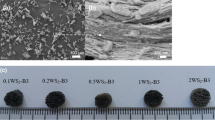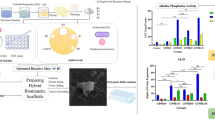Abstract
In the study, tungsten disulfide (WS2) nanoparticle-containing polymer-coated bioactive glass composite scaffolds were prepared for bone tissue engineering applications. Poly-ε-caprolactone (PCL) and poly(D,L-lactide-co-glycolide) (PLGA) were applied on the surface of the bioactive glass scaffolds fabricated by the polymer foam replication method. Results revealed that the presence of WS2 nanoparticles (0.1 to 2 wt%) embedded in polymer matrix improved the compression strength of the prepared scaffolds and their in vitro bioactivity in simulated body fluid. Composite scaffolds did not demonstrate a cytotoxic effect on pre-osteoblastic MC3T3-E1 cells after incubation for 72 h. SEM analysis showed that cells attached to the surface of the scaffolds and spread through the interconnected porous network. Gentamicin-loaded scaffolds demonstrated a controlled drug release behavior depending on the type of polymer applied on the coating layer. The presence of WS2 nanoparticles enhanced the drug release behavior of the scaffolds. It was concluded that bioactive glass-based composites fabricated in the study have the potential to be used for bone tissue engineering purposes.












Similar content being viewed by others
References
Hench LL, Splinter RJ, Allen WC, Greenlee TK Jr (1971) Bonding mechanisms at the interface of ceramic prosthetic materials. J Biomed Mater Res 2:117–141. https://doi.org/10.1002/jbm.820050611
Hench LL, Wilson J (1984) Surface active biomaterials. Science 226:630–636. https://doi.org/10.1126/science.6093253
Rahaman MN, Day DE, Bal BS, Fu Q, Jung SB, Bonewald LF, Tomsia AP (2011) Bioactive glass in tissue engineering. Acta Biomater 7(6):2355–2373. https://doi.org/10.1016/j.actbio.2011.03.016
Eivazzadeh-Keihan R, Chenab KK, Taheri-Ledari R, Mosafer J, Hashemi SM, Mokhtarzadeh A, Maleki A, Hamblin MR (2020) Recent advances in the application of mesoporous silica-based nanomaterials for bone tissue engineering. Mater Sci Eng C 107:110267. https://doi.org/10.1016/j.msec.2019.110267
Gerhard L-C, Boccaccini AR (2010) Bioactive glass and glass-ceramic scaffolds for bone tissue engineering. Materials 3:3867–3910. https://doi.org/10.3390/ma3073867
Stanić V (2019) Chapter 8, Boron-containing bioactive glasses for bone regeneration. Biomed Ther Clin Appl Bioact Glasses 219–249. https://doi.org/10.1016/B978-0-08-102196-5.00008-2
Liang W, Rahaman NM, Day D, Marion N, Riley G, Mao J (2008) Bioactive borate glass scaffold for bone tissue engineering. J Non-Cryst Solids 354:1690–1696. https://doi.org/10.1016/j.jnoncrysol.2007.10.003
Ning J, Yao A, Wang D, Huang W, Fu H, Liu X, Jiang X, Zhang X (2007) Synthesis and in vitro bioactivity of a borate-based bioglass. Mater Lett 61:5223–5226. https://doi.org/10.1016/j.matlet.2007.04.089
Balasubramanian P, Büttner T, Pacheco VM, Boccaccini AR (2018) Boron-containing bioactive glasses in bone and soft tissue engineering. J Eur Ceram Soc 38(3):855–869. https://doi.org/10.1016/j.jeurceramsoc.2017.11.001
Jia W-T, Zhang X, Luo S-H, Liu X, Huang W-H, Rahaman NM, Day D, Zhang C-Q, Xie Z-P, Wang J-Q (2009) Novel borate glass/chitosan composite as a delivery vehicle for teicoplanin in the treatment of chronic osteomyelitis. Acta Biomater 6:812–819. https://doi.org/10.1016/j.actbio.2009.09.011
Sergi R, Bellucci D, Cannillo V (2002) A review of bioactive glass/natural polymer composites: state of the art. Materials 13:5560. https://doi.org/10.3390/ma13235560
Deliormanlı AM (2016) Fabrication and characterization of poly caprolactone coated silicate and borate based bioactive glass composite scaffolds. J Compos Mater 50(7):917–928. https://doi.org/10.1177/2F0021998315583320
Porwal H, Grasso S, Cordero AL, Li C, Boccaccini A, Reece M (2014) Processing and bioactivity of 45S5 Bioglass®-graphene nanoplatelets composites. J Mater Sci Mater Med 25:1403–1413. https://doi.org/10.1007/s10856-014-5172-x
Türk M, Deliormanlı AM (2018) Graphene-containing PCL- coated Porous 13–93B3 bioactive glass scaffolds for bone regeneration. Mater Res Express. https://doi.org/10.1088/2053-1591/aab87b
Ilyas K, Zahid S, Batool M, Chaudhry AA, Jamal A, Iqbal F, Nawaz MH, Goerke O, Gurlo A, Shah AT, Rehman I (2019) In-vitro investigation of graphene oxide reinforced bioactive glass ceramics composites. J Non-Cryst Solids 505:122–130. https://doi.org/10.1016/j.jnoncrysol.2018.10.047
Eivazzadeh-Keihan R, Maleki A, de la Guardia M, Bani MS, Chenab KK, Pashazadeh-Panahi P, Baradaran B, Mokhtarzadeh A, Hamblin MR (2019) Carbon based nanomaterials for tissue engineering of bone: building new bone on small black scaffolds: a review. J Adv Res 18:185–201. https://doi.org/10.1016/j.jare.2019.03.011
Eivazzadeh-Keihan R, Bahojb Noruzi E, Khanmohammadi Chenab K, Jafari A, Radinekiyan F, Hashemi SM, Ahmadpour F, Behboudi A, Mosafer J, Mokhtarzadeh A, Maleki A, Hamblin MR (2020) Metal-based nanoparticles for bone tissue engineering. J Tissue Eng Regen Med 14(12):1687–1714. https://doi.org/10.1002/term.3131
Papageorgiou DG, Kinloch IA, Young RJ (2017) Mechanical properties of graphene and graphene-based nanocomposites. Prog Mater Sci 90:75–127. https://doi.org/10.1016/j.pmatsci.2017.07.004
Yang X, Li J, Hou C, Zhang Q, Li Y, Wang H (2020) Skeleton-structure WS2@CNT thin-film hybrid electrodes for high-performance quasi-solid-state flexible supercapacitors. Front Chem 8:442. https://doi.org/10.3389/fchem.2020.00442
Lin TW, Sadhasivam T, Wang AY, Chen TY, Lin JY, Shao LD (2018) Ternary composite nanosheets with MoS2/WS2/graphene heterostructures as high-performance cathode materials for supercapacitors. Chem Electro Chem 5:1024–1031. https://doi.org/10.1002/celc.201800043
Choudhary N, Li C, Chung H-S, Moore J, Thomas J, Jung Y (2016) High-performance one-body core/shell nanowire supercapacitor enabled by conformal growth of capacitive 2D WS2 layers. ACS Nano 10:10726–10735. https://doi.org/10.1021/acsnano.6b06111
Zhang X, Wang J, Xu H, Tan H, Ye X (2019) Preparation and tribological properties of WS2 hexagonal nanoplates and nanoflowers. Nanomaterials 9(6):840. https://doi.org/10.3390/nano9060840
Hu KH, Wang J, Schraube S, Xu YF, Hu XG, Stengler R (2009) Tribological properties of MoS2 nano-balls as filler in polyoxymethylene-based composite layer of three-layer self-lubrication bearing materials. Wear 266:1198–1207. https://doi.org/10.1016/j.wear.2009.03.036
Lalwani G, Henslee AM, Farshid B, Lin L, Kasper FK, Qin YX, Mikos AG, Sitharaman B (2013) Two-dimensional nanostructure-reinforced biodegradable polymeric nanocomposites for bone tissue engineering. Biomacromol 14:900–909. https://doi.org/10.1021/bm301995s
Kaplan-Ashiri I, Cohen SR, Gartsman K, Ivanovskaya V, Heine T, Seifert G, Wiesel I, Wagner HD, Tenne R (2006) On the mechanical behavior of WS2 nanotubes under axial tension and compression. Proc Natl Acad Sci USA 103:523–528. https://doi.org/10.1073/pnas.0505640103
Zohar E, Baruch S, Shneider M, Dodiuk H, Kenig S, Tenne R, Wagner DH (2011) The effect of WS2 nanotubes on the properties of epoxy-based nanocomposites. J Adhes Sci Technol 25:1603–1617. https://doi.org/10.1163/016942410X524138
Reddy CS, Zak A, Zussman E (2011) WS2 nanotubes embedded in PMMA nanofibers as energy absorptive material. J Mater Chem 21:16086–16093. https://doi.org/10.1039/C1JM12700D
Lalwani G, Henslee AM, Farshid B, Parmar P, Lin L, Qin Y-X, Kasper FK, Mikos AG, Sitharaman B (2013) Tungsten disulfide nanotubes reinforced biodegradable polymers for bone tissue engineering. Acta Biomater 9:8365–8373. https://doi.org/10.1016/j.actbio.2013.05.018
Loffredo F, Tammaro L, Di Luccio T, Borriello C, Villani F, Vito SD, Ramachandran K, Kornfield JA (2021) Effect of tungsten disulfide nanotubes on crystallization of polylactide under uniaxial deformation and annealing. Funct Compos Mater 2:3. https://doi.org/10.1186/s42252-021-00016-2
Redlich M, Gorodnev A, Feldman Y, Kaplan-Ashiri I, Tenne R, Fleischer N, Genut M, Feuerstein N (2008) Friction reduction and wear resistance of electro-co-deposited inorganic fullerene-like WS2 coating for improved stainless steel orthodontic wires. J Mater Res 23:2909–2915. https://doi.org/10.1557/JMR.2008.0350
Samorodnitzky-Naveh GR, Redlich M, Rapoport L, Feldman Y, Tenne R (2009) Inorganic fullerene-like tungsten disulfide nanocoating for friction reduction of nickel-titanium alloys. Nanomedicine 4:943–950. https://doi.org/10.2217/nnm.09.68
Kong N, Ding L, Zeng X, Wang J, Li W, Shi S, Gan ST, Zhu X, Tao W, Ji X (2019) Comprehensive insights into intracellular fate of WS2 nanosheets for enhanced photothermal therapeutic outcomes via exocytosis inhibition. Nanophotonics. https://doi.org/10.1515/nanoph-2019-0343
Chen H, Liu T, Su Z, Shang L, Wei G (2018) 2D Transition metal dichalcogenide nanosheets for photo/thermo-based tumor imaging and therapy. Nanoscale Horiz 3:74–89. https://doi.org/10.1039/C7NH00158D
Teo WZ, Chng ELK, Sofer Z, Pumera M (2014) Cytotoxicity of exfoliated transition-metal dichalcogenides (MoS 2, WS2, and WSe2) is lower than that of graphene and its analogues. Chem Eur J 20:9627–9632. https://doi.org/10.1002/chem.201402680
Chen Y-W, Shie M-Y, Hsiao C-H, Liang Y-C, Wang B, Chen I-WP (2020) Synthesis of high-quality monolayer tungsten disulfide with chlorophylls and its application for enhancing bone regeneration. 2D Mater Appl 4:34. https://doi.org/10.1038/s41699-020-00168-y
Appel JH, Li DO, Podlevsky JD, Debnath A, Green AA, Wang QH, Chae J (2016) Low cytotoxicity and genotoxicity of two-dimensional MoS2 and WS2. ACS Biomater Sci Eng 2:361–367. https://doi.org/10.1021/acsbiomaterials.5b00467
Liu X, Duan G, Li W, Zhou Z, Zhou R (2017) Membrane destruction-mediated antibacterial activity of tungsten disulfide (WS2). RSC Adv 7:37873–37880. https://doi.org/10.1039/C7RA06442J
Pardo M, Shuster-Meiseles T, Levin-Zaidman S, Rudich A, Rudich Y (2014) Low cytotoxicity of inorganic nanotubes and fullerene-like nanostructures in human bronchial epithelial cells: relation to inflammatory gene induction and antioxidant response. Environ Sci Technol 48:3457–3466. https://doi.org/10.1021/es500065z
Türk M, Deliormanlı AM (2017) Electrically conductive borate based bioactive glass scaffolds for bone tissue engineering applications. J Biomater Appl 32(1):28–39. https://doi.org/10.1177/2F0885328217709608
Kokubo T, Kushitani H, Sakka S, Kitsugi T, Yamamuro T (1990) Solutions able to reproduce in vivo surface-structure change in bioactive glass-ceramic A-W. J Biomed Mater Res 24:721–734. https://doi.org/10.1002/jbm.820240607
Du C, Ma H, Ruo M, ZhangYu ZX, Zeng Y (2006) An experimental study on the biomechanical properties of the cancellous bones of distal femur. Biomed Mater Eng 16:215–222. https://pubmed.ncbi.nlm.nih.gov/16518020/
Simić DM, Stojanović DB, Dimić M, Mišković K, Marjanović M, Burzić Z, Uskoković PS, Zak A, Tenne R (2019) Impact resistant hybrid composites reinforced with inorganic nanoparticles and nanotubes of WS2. Compos B Eng 176(107222):107222. https://doi.org/10.1016/j.compositesb.2019.107222
Lynn GJ (2015) Dissolution of borate glasses and precipitation of phosphate compounds. Doctoral Dissertations. 2382. https://scholarsmine.mst.edu/doctoral_dissertations/2382
Pawlik J, Łukowicz K, Cholewa-Kowalska K, Osyczka AM (2019) New insights into the PLGA and PCL blending: physico-mechanical properties and cell response. Mater Res Express 6:085344. https://doi.org/10.1088/2053-1591/ab2823
Zhang L, Liu X, Li G, Wang P, Yang Y (2018) Tailoring degradation rates of silk fibroin scaffolds for tissue engineering. J Biomed Mater Res Part A 9999:1–10. https://doi.org/10.1002/jbm.a.36537
Gadaleta SJ, Paschalis EP, Betts F, Mendelsohn R, Boskey AL (1996) Fourier transform infrared spectroscopy of the solution-mediated conversion of amorphous calcium phosphate to hydroxyapatite: New correlations between X-ray diffraction and infrared data. Calcif Tissue Int 58:9–16. https://doi.org/10.1007/BF02509540
Fu Q, Rahaman MN, Fu H, Liu X (2010) Silicate, borosilicate, and borate bioactive glass scaffolds with controllable degradation rate for bone tissue engineering applications. I. Preparation and in vitro degradation. J Biomed Mater Res A 95(1):164–171. https://doi.org/10.1002/jbm.a.32824 (PMID: 20544804)
Garcia-Hevia L, Roehrer I, Mazzocchi T, Menciassi A, Ricotti L (2020) Cytotoxicity of pristine and functionalized tungsten disulfide particles in the urinary system. J Nanopart Res 22:273. https://doi.org/10.1007/s11051-020-05007-1
Goldman EB, Zak A, Tenne R, Kartvelishvily E, Levin-Zaidman S, Neumann Y, Stiubea-Cohen R, Palmon A, Hovav A-H, Aframian DJ (2015) Biocompatibility of tungsten disulfide inorganic nanotubes and fullerene-like nanoparticles with salivary gland cells. Tissue Eng Part A 21(5–6):1013–1023. https://doi.org/10.1089/ten.tea.2014.0163
Chang R, Palumbo A, Tourlomousis F, Yang EH (2017) Transition metal dichalcogenides as cell culture platforms. Tech Connect Briefs 1:99–102
Srikanth M, Heath M, Shang-You Y, Asmatulu R (2015) Effects of morphology, concentration and contact duration of carbon-based nanoparticles on cytotoxicity of L929 cells. V014T11A027. https://doi.org/10.1115/IMECE2015-52296
Milosevic M, Stojanovic DB, Simic V, Grkovic M, Bjelovic M, Uskokovic PS, Kojic M (2020) Preparation and modeling of three-layered PCL/PLGA/PCL fibrous scaffolds for prolonged drug release. Sci Rep 10:11126. https://doi.org/10.1038/s41598-020-68117-9
Rai A, Senapati S, Saraf SK, Maiti P (2016) Biodegradable poly(e-caprolactone) as a controlled drug delivery vehicle of vancomycin for the treatment of MRSA infection. J Mater Chem B 4:5151–5160. https://doi.org/10.1039/C6TB01623E
Acknowledgements
The financial support for this research was provided by the Scientific and Technical Research Council of Turkey (TUBITAK), Grant No: 119M935.
Author information
Authors and Affiliations
Corresponding author
Ethics declarations
Conflict of interest
The authors declared no potential conflicts of interest with respect to the research, authorship and/or publication of this article.
Additional information
Handling Editor: Annela M. Seddon.
Publisher's Note
Springer Nature remains neutral with regard to jurisdictional claims in published maps and institutional affiliations.
Rights and permissions
About this article
Cite this article
Ensoylu, M., Deliormanlı, A.M. & Atmaca, H. Tungsten disulfide nanoparticle-containing PCL and PLGA-coated bioactive glass composite scaffolds for bone tissue engineering applications. J Mater Sci 56, 18650–18667 (2021). https://doi.org/10.1007/s10853-021-06494-w
Received:
Accepted:
Published:
Issue Date:
DOI: https://doi.org/10.1007/s10853-021-06494-w




